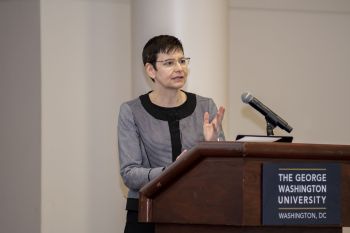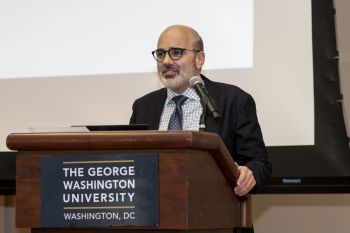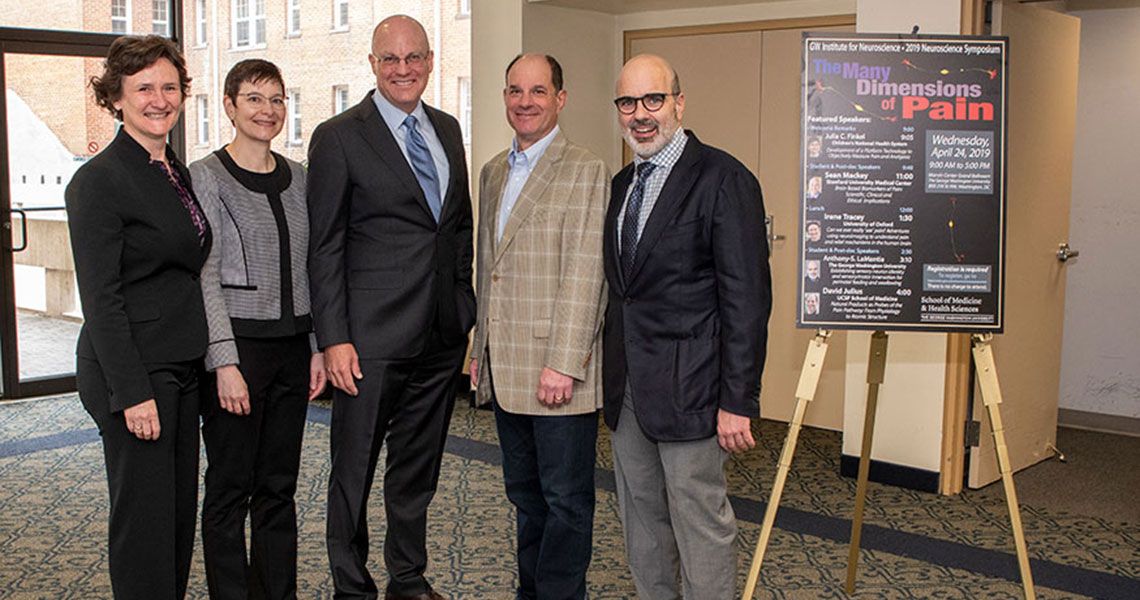More than 50 million adults in the United States, about 20 percent of the population, suffer from chronic pain every day, according to the Centers for Disease Control. Pain is an area Anthony S. LaMantia, PhD, director of the George Washington University (GW) Institute for Neuroscience, has long wanted to address during the institute’s annual symposium; in its ninth year, that topic was finally the focus of the event.
“This issue had dominated the science of our brains and minds for centuries and centuries,” said LaMantia, who also serves as the Jeffery A. Lieberman Professor of Neuroscience at the GW School of Medicine and Health Sciences (SMHS). “It is really a great pleasure to welcome everybody here to think about this issue of pain, its representation, its biological basis, and its clinical significance.”
Robert H. Miller, PhD, vice president for research at GW and senior associate dean for research SMHS, added that often pain is an area that does not get the attention it deserves from the neurological science community, and that it is both a complicated and major problem. He added that at GW and in SMHS, the neurological sciences are an increasingly important focus for research development.
“As you look across at what the talks are on today, you can see we have a broad spectrum with a number of grad students and junior researchers who are presenting work that’s emerging,” he said “I think that gives us insight into the new generation of neuroscientists who are going to move the needle forward in the coming years.”
The first lecture of the event was presented by Julia C. Finkel, MD, director of Pain Medicine R&D, in the Sheikh Zayed Institute for Pediatric Surgical Innovation at Children’s National Health System (Children’s National) and professor of anesthesiology, pediatrics, and critical care at SMHS. Finkel’s talk focused on the use of technology to create a better understanding of a patient’s pain and their response to analgesic drugs, including opioids. “Our standard of care is our subjective pain scales, and while they offer a summary of all the things that come to bare in our perception of pain, they do nothing to distinguish the various elements,” she said.

Finkel said her work focuses on using technology to tease out the nociceptive elements of pain, or the sensory nervous system response. A tool currently being developed at Children’s National features a pain biometric that allows researchers to generate a profile of the patient’s response to pain as an objective measure of its type and intensity. The tool also allows for the production of a decision-dosing tool and a non-invasive, rapid drug test to be used to identify the presence of certain drugs such as THC, alcohol, and amphetamines, among others.
The platform, she explained, is hand-held and integrates several pupillary responses into a report that can be used by a clinician. Pupillary reflex dilation, she said, is a more sensitive measure of noxious stimulation when compared to measuring heart rate and blood pressure.
The symposium also featured five presentations from SMHS graduate and post-doctoral students, as well as three plenary lectures.
Sean Mackey MD, PhD, who is the Redlich Professor of Anesthesiology, Perioperative, and Pain Medicine and chief of the Division of Pain Medicine at Stanford University delivered the first of the plenary lecture of the symposium.
Mackey’s research, viewed through a “clinician’s lens,” centers on discovering brain-based biomarkers for pain using brain imaging. That could hold the potential for advancing the goal of precision pain management using brain imaging to elucidate the “truth” of pain, he said.
Biomarkers, he said, could help clinicians “identify targets that are novel in nature to go after pain, and also to achieve a goal of precision pain medicine to target the right treatment, for the right person, for the right circumstances.”
Following Mackey’s lecture, Irene Tracey, PhD, Nuffield Chair of Anaesthetic Science and head of the Nuffield Department of Clinical Neurosciences at the University of Oxford, presented a plenary talk on “Imaging Pain, Analgesia and Anesthesia.”
One of Tracey’s focuses is on how patients can reframe or cope with their pain. People, she said, have an amazing capacity to turn pain up or turn pain down. “Fundamentally, you have pain to drive a decision to act, to do something about it, and you need to make the right decision,” she said. “And in certain contexts, maybe the right decision is to put up with the pain because if you get distracted by it, something worse is going to happen.”
“How you rate the moderate burn in one session of 20 minutes completely changes whether you are expecting the high and I give you the moderate or you were queued to expect the low and I give you the moderate. You don’t like the moderate burn when you’re expecting the low, but you love the moderate burn when you’re expecting the high, because it could have been worse,” she explained.
“When you’re expecting it to be bad, but it wasn’t so bad, you bring a relief mechanism to it and it makes it better,” she said. “You still know it’s moderate pain, on an intensity dimension, but your unpleasantness flips to be pleasant and you can hedonically flip it.”

In the afternoon, LaMantia also presented work from his laboratory, telling attendees that he would address the issues discussed throughout the day from a different perspective. He discussed his research on “Establishing Sensory Neuron Identity and Innervation for Perinatal Feeding and Swallowing,” about how to build a system that can represent painful information and integrate it into very well-defined behavior.
One innate behavior that is not often studied is feeding and swallowing, LaMantia said, behaviors that are necessary to stay alive and must be in place at birth for growth and health. Suboptimal feeding and swallowing is known as dysphagia, and in the youngest patients as pediatric dysphagia. LaMantia’s research specifically looks at the biological basis of pediatric dysphagia in the neurodevelopmental disorder 22q11 deletion syndrome.
His investigation explores setting up cranial nerve circuitry that is essential for optimal feeding and swallowing, and whether there’s a distinct mechanism the puts this circuitry in place to integrate sensory inputs and motor control for feeding and swallowing in newborns and infants. LaMantia’s work indicates that this circuitry is the target of changes in early development that lead to feeding and swallowing problems.
As the day wrapped up, David Julius, PhD, Morris Herzstein Chair of Molecular Biology and Medicine and chair of the Department of Physiology at the University of California, San Francisco, gave the final plenary presentation.
His talk centered on physiology and understanding nervous system control of the gut and its relation to visceral pain syndromes, including irritable bowel syndrome.
“There’s this question of trying to understand whether there are mechanistically distinct aspects of these syndromes, and, if so, it then suggests that they’re pharmacologically distinct and says that we really have to understand the molecular, cellular and neuro aspects of what teases these different syndromes apart before we really can think mechanistically about how to address them using pharmacological tools,” he said.
While the mechanisms remain largely unknown, he added, they likely include a combination of interactions with the microbiome and other things that go through the lumen and intestinal tract, and certainly inflammation followed by peripheral nerve sensitization and central sensitization, and the goal is to parse out these mechanisms and to see how it works. Julius’ work has found a novel sensory pathway that is exquisitely tuned to detecting pain-inducing stimuli in the gut.
After Julius’ talk, LaMantia wrapped up the event and praised the many speakers and attendees who made it such a fascinating day of research discussions and revelations.



